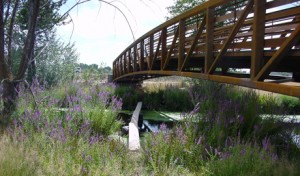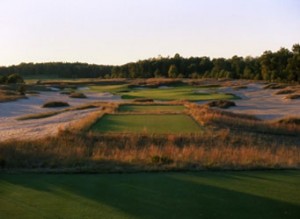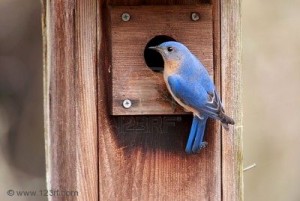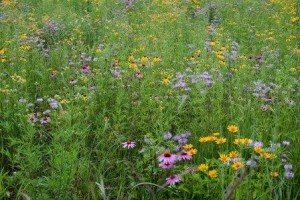I have a confession to make.
Many years ago on a well-known Michigan course, I tried to hit a wetland laden par-5 in two – and missed. Venturing into the semi- hardened muck and mud, actually a ‘natural area’ unknown to me at the time, I not only found my ball, but 80 others in a 5 minute time span. What fortune! I basked in my own glory until discovering a sign yanked rudely out of the ground and tossed aside: ‘Environmentally Sensitive Area – DO NOT ENTER’.
I probably should have returned the golf balls to their rightful resting place but was hesitant to venture back into such a forbidden area, newly informed.
Today, those signs are everywhere. But what do they really mean? How did they get there?
In recent times, detractors have denounced golf courses as polluters of the environment and that their construction does not parallel preservation purposes. It may have been true many years ago but one can hardly say that kind of shoddy craftsmanship goes on today. Not only would it be shamefully unconscionable, but local, state, and federal government agencies might be a bit miffed.
Enter Audubon International (AI). You’ve heard the name before, as in John James Audubon, dominant wildlife artist and keen observer of birds. With that in mind, isn’t Audubon all about watching birds? And, what does that have to do with golf?’
To answer the question, one needs to clear up a common misunderstanding. Though they share the same namesake, Audubon International has absolutely nothing to do with the National Audubon Society. Perhaps the two groups share a love of birds and bird watching, but that’s where it ends. However, it is fitting that the younger Audubon International organization, formed in 1987, is also named after a man who was described as ‘triumphing over adversity’, possessing ‘strength and endurance’ and who ‘encapsulated the spirit of a young America’ during the early 1800’s. Sounds like the portrait of a golfer to me.
Actually, Audubon International oversees a number of programs, besides golf, which protect the environment. According to a Mission Statement: “Audubon International educates, assists and inspires millions of people from all walks of life to protect and sustain the land, water, wildlife and natural resources around them.”
More specifically, the Audubon Cooperative Sanctuary Program for Golf Courses (ACSP), created in 1991, is a highly specialized award winning certification program which educates, enhances, and protects the heritage of the game of golf. According to ACSP Program Director Joellen Lampman, “Give people the right reasons to take environmental stewardship seriously, along with tools, information, and incentives for action, and they will embrace their responsibility to nature.” At its conception, a few hundred brave courses stepped forward to take part in this landmark initiative funded by the USGA. Now, there are more than 2000 golf courses in 36 countries dedicated to working in harmony with nature. Divided into two separate affiliations, the ACSP is for already established golf courses which implement and document environmental management practices to earn their Sanctuary status. The other, the Audubon Signature Program, spun off in 1993, is solely for proposed projects still in the development stage which adhere to stringent practices as the course is being built and developed. Currently, dozens of golf course Signature development projects are in various states of action in the U.S. and other countries.
There are three levels of the Audubon Signature Program: Gold, Silver, and Bronze. Membership in these depends upon the complexity of the project, the level of Audubon involvement in planning and follow-up, and at which stage of development the project was in. Initial costs vary into the thousands of dollars and there are also annual renewal fees. These fees may seem steep but considering that Audubon professionals monitor and assist with all phases of development, construction, and follow-up of these massive projects – including multiple site visits – the peace of mind that accompanies knowing the project is ecologically safe and sound is worth the price. Currently, there are only 18 Signature Gold properties. Florida boasts 9, North Carolina has 5, California has 2, and the rest are sprinkled in other states.
Truckee, California, though a small town, has two Signature Gold courses, the Jack Nicklaus designed Old Greenwood, and sister club, The Golf Club at Gray’s Crossing. Anyone who has ever enjoyed the circle tour of Lake Tahoe and into the High Sierras would not be surprised at the efforts to preserve this pristine and unsurpassed mecca of golf. The drive from South Lake Tahoe, Nevada up into Truckee, CA is one no golfer should miss as the road winds around ice-blue Lake Tahoe and skirts the brisk and fast-moving Truckee River; if ever there was a reason necessary to understand the need for environmental protection, the Tahoe/Truckee area is it.
Gulf Coast Mississippi has two Silver Signature courses within an hour of one another: The Bridges in Bay St. Louis, which was actually the first resort course in the world to be granted Silver status, is an Arnold Palmer design and at 7,000 yards, needs 21 bridges to transport the golfer across 17 lakes, numerous creeks, and wetlands. The Preserve, a Jerry Pate creation in Vancleave, boasts peaceful surroundings and immaculate conditions via daily walk-mowing and hand-raking – a rare practice these days. In the winter, greens are kept covered to maintain turf consistency. Tucker, the golf course Labrador, keeps a watchful eye on every aspect of course maintenance while riding shotgun with Director of Operations Stephen Miles.
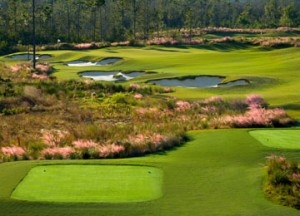
Wetlands and white sands galore, but The Preserve's walk-mown fairways are wide enough to negotiate.
Given the good fortune of being surrounded by the Great Lakes, Michigan is especially conscientious of protecting its environment. With over 850 golf courses, the state leads the nation in sheer number of courses available for public play. Currently, only one Signature Gold course exists in Michigan, and it is a dandy: Forest Dunes GC in Roscommon was recently added to Golf Digest Magazine’s 100 Greatest Courses roster. In addition to stunning scenery, perfect conditioning, and an impeccable Tom Weiskopf design, the course was molded with local flair and talent. Michigan’s own Tom Smith, Executive Director of the Michigan Turfgrass Foundation, ‘discovered’ the par-3 16th.
“It was a pure hole, a natural dunes area,” said Smith. “We molded the course after this and basically re-did the whole back nine to isolate the turf areas among the natural dunes. Mr. Weiskopf designed the layout, but the look, well, everything that is not green, is mine. Fine fescue had been ordered to do the rough but was sent back when the dune concept was born.”
Forest Dunes also sets the gold standard for excellence in many areas including chemical and pest management practices any golfer would value: use of low impact chemicals, spot application for weed and disease control, use of organic based fertilizers, bi-annual soil testing, weather monitoring to assist in proper timing of all applications, pesticides sprayed on a curative basis only, daily scouting and evaluation of turf water requirements, and use of grasses which are drought tolerant and have good disease resistance.
Other areas of interest and ACSP directives environmentally curious golfers can look for are:
Water quality management: no-spray/limited spray zones near all open water, aerators in ponds with adequate lake depths to reduce algae growth, ponds lined during construction so that nothing harmful can reach the groundwater;
Water conservation: limited irrigated turf areas due to native plants’ incorporation, some hand watering, raising of turf mower heights, decorative landscaping around clubhouse and homes using native plants requiring little or no water;
Wildlife conservation and habitat enhancement: more native areas and wildlife corridors and less maintained turf, nesting boxes and loon nesting platforms, added brush, trees, and aquatic vegetation to lakes for fish habitat, leaving deadwood and fallen timber so as not to disturb existing animal habitats, and prescription burning to reduce invasive weeds and reduce competition – which also reduces the use of chemicals.
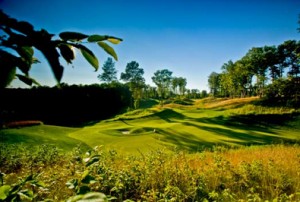
Impeccable conditions mirror incredible beauty at Michigan's True North Golf Club. Photo courtesy of Peter Andraes.
True North in Harbor Springs is the only Silver Signature golf course in Michigan. Owner John Hover took over the club in 2006 and is continuing the journey toward certified status with talented course superintendent Steve Sump. The course is a gorgeous mix of elevation, woodlands, ponds, and other natural surroundings maintained by natural methods set forth by AI. In fact, the managed turf area of True North occupies approximately 73 acres while the native areas cover over 77 acres. Wildlife commands the right of way here; and because the course is surrounded on three sides by state land and conservation easements, True North will enjoy true serenity for many years to come.
Gull Lake View in Augusta is a complex consisting of 5 separate courses, all of which have been ACSP members since 1995. Co-owner and Grounds Director Charlie Scott stressed that all of us need to be aware of our environmental situation.
“People don’t realize how tenuous it is. Do they know how lucky we are in Michigan to have the water situation we do? In California it can cost over $250,000 per year for irrigation. Here, it costs me only what I pay to run the pumps,” he said, and added, “we take seriously our role as protectors and stewards. We have to want to do it. There’s really no incentive unless something goes wrong. If you can prevent issues, those dollars will be less than it would be to fix them.”
In keeping with the community outreach programs ACSP requires, Gull Lake works with the Kalamazoo Nature Center and the Community Wildlife Education Director, monitoring 125 bluebird boxes on the course. Beginning in April, volunteers record species, band 10-14 day old birds, and chart their return. Tree swallows also make their nests on the course, migrate to South America, and then return to the exact same box each year…..sort of the original GPS nav system. In the clubhouse pro shops there are recording stations where golfers can write what they saw on the complex.
One unique feature at Gull Lake is the latest project the Scott family has undertaken: Crane’s Pond, which is a Silver Signature residential development. Basically a planned community, this subdivision consists of detached condominiums where people will own the property jointly along with the open space. Walkways, paths, a kids’ park, playground, and a community park will comprise about 60% of the total 200 acre parcel and will follow the basic tenets set forth by Audubon International.
Fox Hills in Plymouth has been a Cooperative Sanctuary course since the early 90’s. Co-owners and sisters Kathy Aznavorian and Sandy Mily, and their mother, Estelle Dul, felt that golf courses got a bad rap because of their chemical and pesticide use. In order to turn a bad situation into a positive spin, they decided to learn what to do to minimize costs through better planning.
“What amazed me was discovering what I didn’t know about a golf course environment. It has been a great educational adventure,” said Aznavorian.
Environmental education is vital at Fox Hills: Greens Superintendent Eric Niemur gives PowerPoint presentations to area schools, Rotary Clubs, and Kiwanis groups; course personnel work with Salem Elementary School to observe bird nesting boxes, and like Gull Lake, a bluebird birdhouse course construction project was undertaken to correct a 50-year decline in the Eastern Bluebird. Inside the clubhouse, there is a display cabinet with authentic bird carvings for easier identification of species; and a special section of Fox Hills’ regular newsletter is devoted to environmental information.
Aznavorian found that by using a diversity of plantings they could increase wildlife by changing host plants. Choosing different shrubs and plants attracts different species. Now there are Baltimore Orioles, hawks, and even mink. Butterflies and hummingbirds love the trumpet vines surrounding the wedding gazebo. Natural prairie grasses require basically no maintenance, yet are great cover for birds, deer, and pheasant parades.
When asked if people seek out Fox Hills because of their natural practices, Aznavorian replied, “There’s really no financial gain; it is simply the right thing to do. We are stewards of the land and it is ours only to borrow. We have to give back the land better than when we found it. People complain about golf courses taking up open spaces. Well, at least we aren’t a Meijer’s parking lot!”
The newest club to join the Audubon Cooperative Sanctuary fold is also one of the most breathtaking courses in the state: The Legend at Shanty Creek, in Bellaire. One of the first items on new course superintendent Chad Corp’s priority list was to work towards ACSP status, which began in 2006. Chemical and fertilizer reduction programs are already in place and the outreach programs necessary to complete the certification are slated for area schools in the near future.
“I’m an anti-fertilizer kind of guy. We are hoping to educate people as to why some areas of the course are not as green, or why we’ll leave unmowed some fairways on par-3’s; but they’ll appreciate it when they see deer and foxes rummaging around in those long grasses,” explained Corp.
Working on this designation does not come without price. Interestingly enough, the organic and healthy foods initiative enlightened humans are embracing in this country’s climate of ill-health and obesity applies to golf courses as well. By ‘feeding’ The Legend organic and micro-nutrient laden foods and fertilizers, Corp said that the need for pesticides, chemicals, and other fixes would be lessened. Yes, it is more expensive, with organic fertilizer’s price tag per bag at almost twice the cost of normal fertilizer. However, in the long run, the price is worth it for a safer and more attractive natural environment. There’s a lesson to be learned here: proper diet equals a healthier and chemical free existence.
Other public courses in the Cooperative Sanctuary Program up north on the eastern Sunrise Side of the state are Black Lake GC, owned by the UAW in Onaway and Bruce and Donna Wolfrom’s White Pine National in Spruce. Both courses are natural wonders whose owners take great pride in providing a terrific golf experience as well as a walk through a nature preserve with many species of animals and birds roving about.
While Michigan is getting kicked in the teeth economically and is the butt of jokes around the nation, there are two positives here no one can take away. First, the greatest gift the Great Lakes State has is the abundance of fresh water, of which the stewardship in maintaining its quality is paramount. Golf courses are serious about preserving those resources.
Kathy Aznavorian, had never been aware that their mowing practices of nipping turf up to the edge of ponds had a detrimental effect. “Apparently by our actions, we were unknowingly allowing chemicals and fertilizers to leach into the water,” she said. “Now, we leave the grass longer to trap the pollutants.” Certainly the golfers appreciate it and won’t ‘leach’ as many golf balls into the water.
Secondly, the homegrown Michigan Turfgrass Environmental Stewardship Program (MTESP) is recognized as one of the most effective programs in the nation. Founded at Michigan State University and in cooperation with the Michigan Turfgrass Foundation, the Golf Association of Michigan, and the Michigan Departments of Agriculture and Environmental Quality, over 240 member courses voluntarily implement measures to prevent pollution, protect water resources, enhance wildlife habitat, and reduce energy use. There are 20 ACSP courses in Michigan and most are members of the MTESP as well.
Once courses know about ACSP it would seem a no-brainer to join. However, that leap is one of the biggest hurdles for Audubon International to overcome. Back in 2003, AI had set an ambitious goal of 50% membership of over 17,000 courses throughout the U.S. by 2007. At the time, 13% of U.S. courses were members of either the ACSP or the Signature Program, with only 2% taking additional steps to become certified. Though nowhere near that goal, over 50% of Golf Digest Magazine’s top 100 courses are ACSP members. Obviously quality equates with conscientiousness.
So, why wouldn’t a course attain ACSP status if it is good for both the course and the environment? The answer lies in the perceived time, effort, and expense needed to work within the program. Larry Bowden, creator of The Natural in Gaylord had this to say:
“I was a member of ACSP from 1993 to about 1999 until I lost my course superintendent who had the zeal for this. Unfortunately, I couldn’t continue though I still think it is a great idea. Without the staff and support, you can’t do what needs to be done. An owner cannot do it all.”
However, the ASCP maintains that by following the guidelines, less turf maintenance through growing out more natural areas saves work and greens personnel can spend their time elsewhere. If you play at a course that is not a member of either the ACSP, please encourage the owner to consider becoming one. Or, if you own a course, consider joining. It takes four steps:
1) Join the program. Check out how on their website at www.auduboninternational.org.
2) Complete a Site Assessment and Environmental Plan. AI will help with environmental planning, wildlife and habitat management, chemical use reduction and safety, water conservation, water quality management, and outreach and education.
3) Implement an Action Plan. Work with course staff and IA to put an Assessment and Environmental Plan into action.
4) Become certified. Putting plans into action and documenting them after completion. Some courses may be amazed to find their current practices already meet certification requirements.
Or, if your state does not have its own initiative, contact the Michigan Turfgrass Environmental Stewardship Program for help in setting up your own version. Go to www.mtesp.org or call 517.355.0271.
Either way, everyone wins. It is up to us to patronize the hundreds of courses which take extra care in keeping their properties ‘green’ and……maybe not so green……..by preserving water and natural resources. Enjoy the sights and the sounds of nature doing what it does best: surviving.
Oh yes, about those contraband golf balls. To ease my conscience, I donated them to a junior golf program……

